BUS104 - Introduction to Management: McDonald's Leadership Analysis
VerifiedAdded on 2022/12/20
|10
|2304
|2
Report
AI Summary
This report provides an in-depth analysis of McDonald's, covering its organizational history, purpose, values, and divisional structure. It examines the roles and responsibilities of the CEO, Andrew Gregory, including the four functions of management: planning, organizing, leading, and managing. The report highlights the skills required for effective leadership, such as human, technical, and conceptual skills, and how these skills contribute to maintaining a positive work environment. Furthermore, it compares the roles of the CEO and assistant managers, explores the challenges of operating in a competitive business environment, and contrasts the roles of CEOs in for-profit and non-profit organizations. The report emphasizes the importance of innovation, customer service, and transformational leadership in achieving sustainable competitive advantages within the fast-food industry. The provided references support the analysis with credible sources.
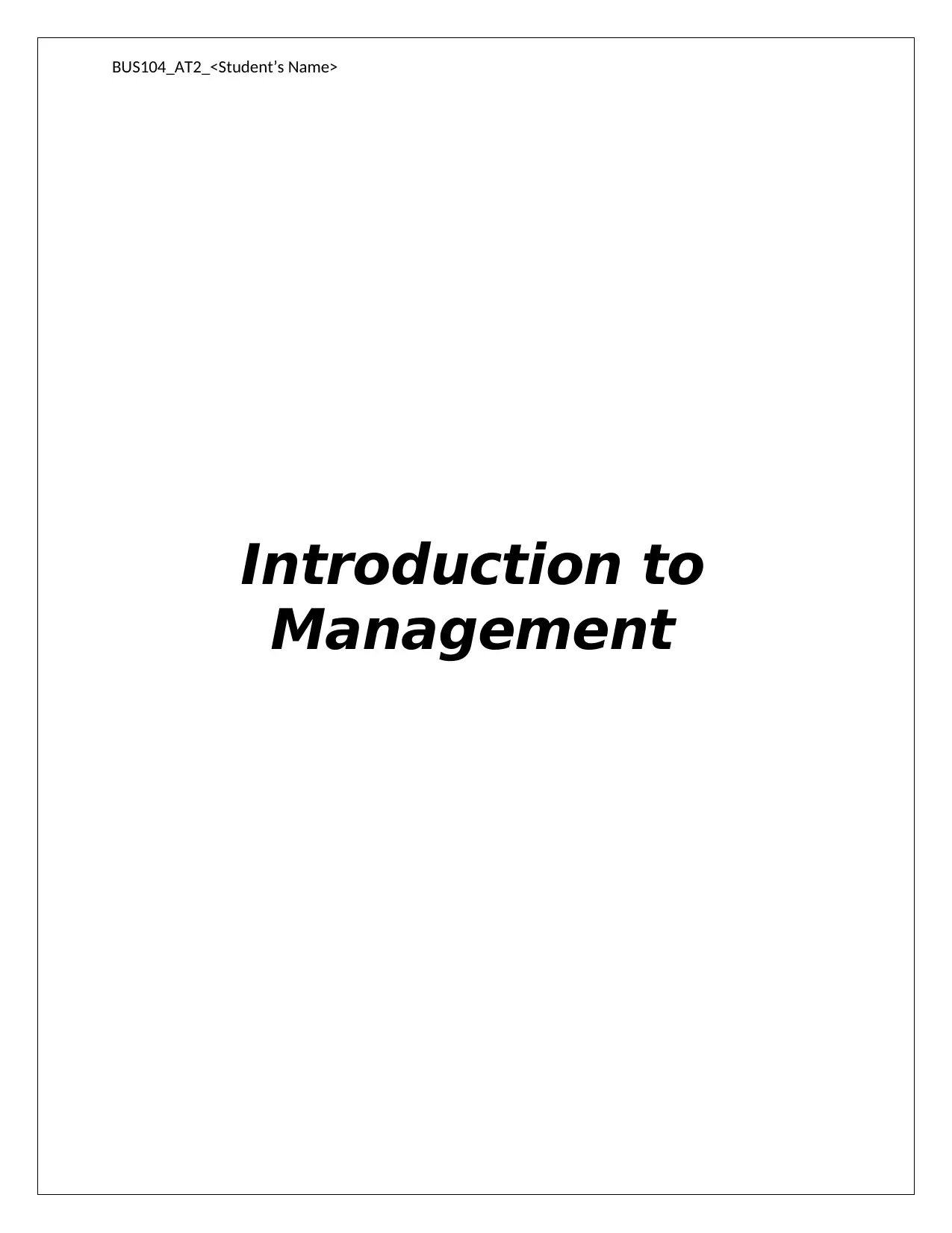
BUS104_AT2_<Student’s Name>
Introduction to
Management
Introduction to
Management
Paraphrase This Document
Need a fresh take? Get an instant paraphrase of this document with our AI Paraphraser
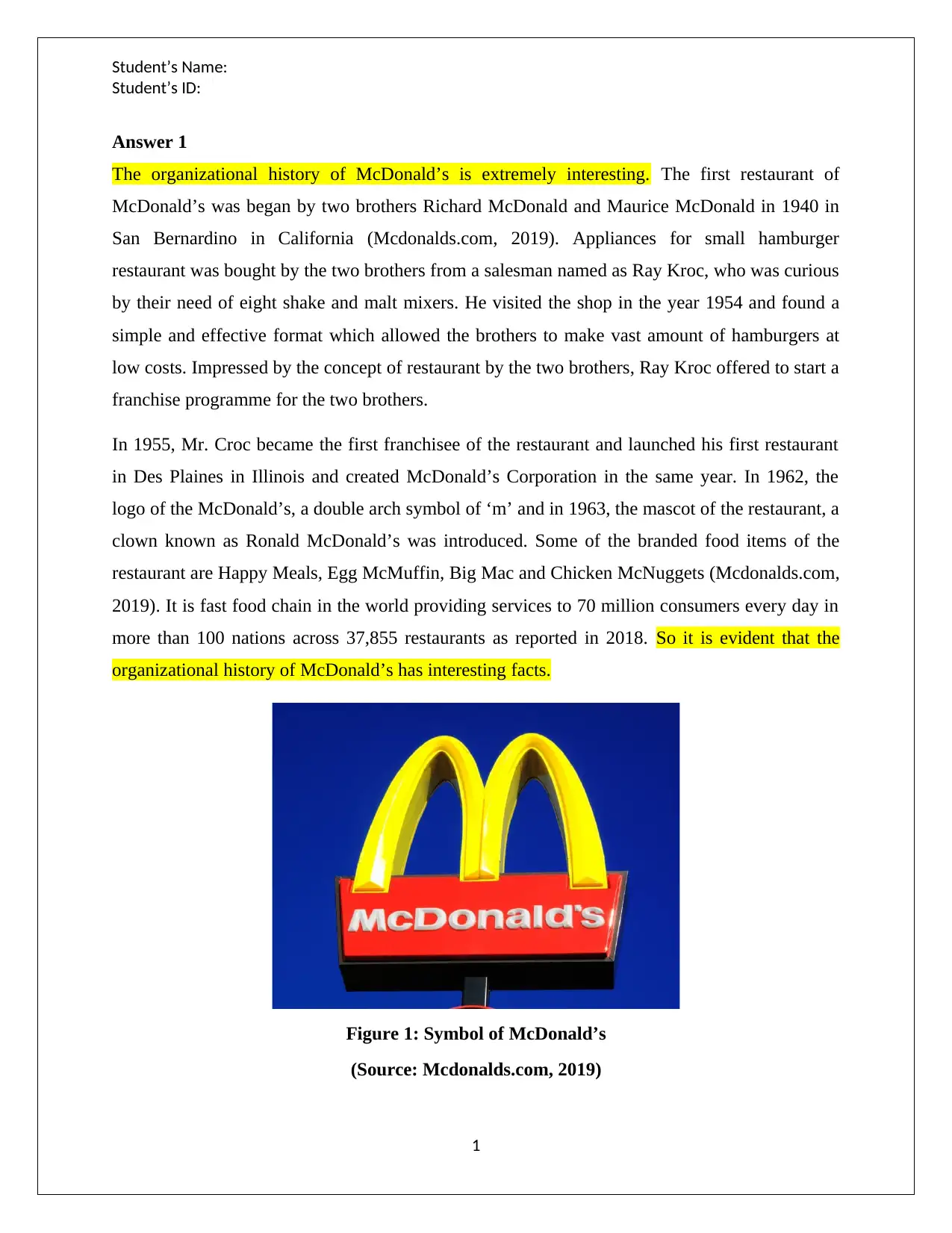
Student’s Name:
Student’s ID:
Answer 1
The organizational history of McDonald’s is extremely interesting. The first restaurant of
McDonald’s was began by two brothers Richard McDonald and Maurice McDonald in 1940 in
San Bernardino in California (Mcdonalds.com, 2019). Appliances for small hamburger
restaurant was bought by the two brothers from a salesman named as Ray Kroc, who was curious
by their need of eight shake and malt mixers. He visited the shop in the year 1954 and found a
simple and effective format which allowed the brothers to make vast amount of hamburgers at
low costs. Impressed by the concept of restaurant by the two brothers, Ray Kroc offered to start a
franchise programme for the two brothers.
In 1955, Mr. Croc became the first franchisee of the restaurant and launched his first restaurant
in Des Plaines in Illinois and created McDonald’s Corporation in the same year. In 1962, the
logo of the McDonald’s, a double arch symbol of ‘m’ and in 1963, the mascot of the restaurant, a
clown known as Ronald McDonald’s was introduced. Some of the branded food items of the
restaurant are Happy Meals, Egg McMuffin, Big Mac and Chicken McNuggets (Mcdonalds.com,
2019). It is fast food chain in the world providing services to 70 million consumers every day in
more than 100 nations across 37,855 restaurants as reported in 2018. So it is evident that the
organizational history of McDonald’s has interesting facts.
Figure 1: Symbol of McDonald’s
(Source: Mcdonalds.com, 2019)
1
Student’s ID:
Answer 1
The organizational history of McDonald’s is extremely interesting. The first restaurant of
McDonald’s was began by two brothers Richard McDonald and Maurice McDonald in 1940 in
San Bernardino in California (Mcdonalds.com, 2019). Appliances for small hamburger
restaurant was bought by the two brothers from a salesman named as Ray Kroc, who was curious
by their need of eight shake and malt mixers. He visited the shop in the year 1954 and found a
simple and effective format which allowed the brothers to make vast amount of hamburgers at
low costs. Impressed by the concept of restaurant by the two brothers, Ray Kroc offered to start a
franchise programme for the two brothers.
In 1955, Mr. Croc became the first franchisee of the restaurant and launched his first restaurant
in Des Plaines in Illinois and created McDonald’s Corporation in the same year. In 1962, the
logo of the McDonald’s, a double arch symbol of ‘m’ and in 1963, the mascot of the restaurant, a
clown known as Ronald McDonald’s was introduced. Some of the branded food items of the
restaurant are Happy Meals, Egg McMuffin, Big Mac and Chicken McNuggets (Mcdonalds.com,
2019). It is fast food chain in the world providing services to 70 million consumers every day in
more than 100 nations across 37,855 restaurants as reported in 2018. So it is evident that the
organizational history of McDonald’s has interesting facts.
Figure 1: Symbol of McDonald’s
(Source: Mcdonalds.com, 2019)
1
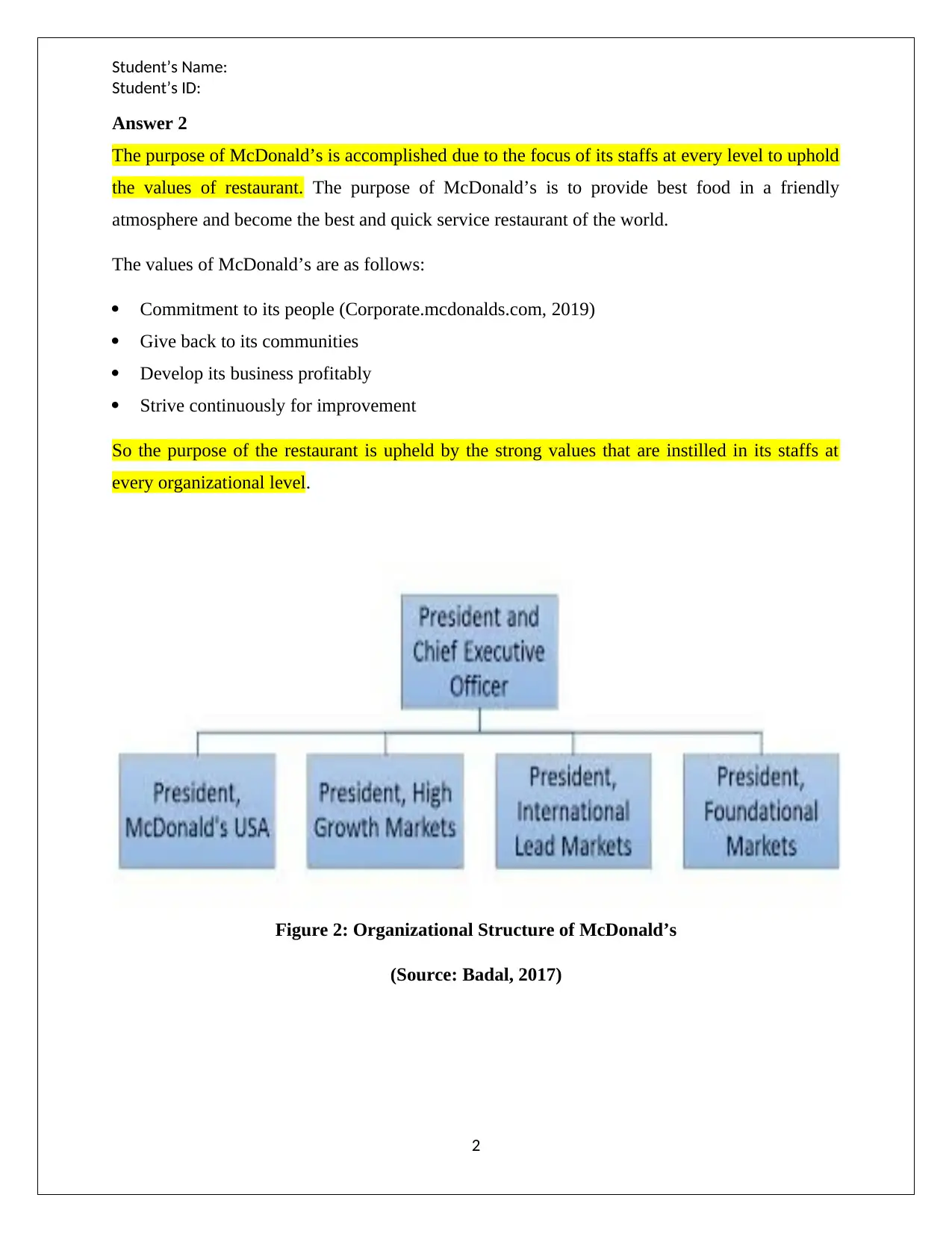
Student’s Name:
Student’s ID:
Answer 2
The purpose of McDonald’s is accomplished due to the focus of its staffs at every level to uphold
the values of restaurant. The purpose of McDonald’s is to provide best food in a friendly
atmosphere and become the best and quick service restaurant of the world.
The values of McDonald’s are as follows:
Commitment to its people (Corporate.mcdonalds.com, 2019)
Give back to its communities
Develop its business profitably
Strive continuously for improvement
So the purpose of the restaurant is upheld by the strong values that are instilled in its staffs at
every organizational level.
Figure 2: Organizational Structure of McDonald’s
(Source: Badal, 2017)
2
Student’s ID:
Answer 2
The purpose of McDonald’s is accomplished due to the focus of its staffs at every level to uphold
the values of restaurant. The purpose of McDonald’s is to provide best food in a friendly
atmosphere and become the best and quick service restaurant of the world.
The values of McDonald’s are as follows:
Commitment to its people (Corporate.mcdonalds.com, 2019)
Give back to its communities
Develop its business profitably
Strive continuously for improvement
So the purpose of the restaurant is upheld by the strong values that are instilled in its staffs at
every organizational level.
Figure 2: Organizational Structure of McDonald’s
(Source: Badal, 2017)
2
⊘ This is a preview!⊘
Do you want full access?
Subscribe today to unlock all pages.

Trusted by 1+ million students worldwide
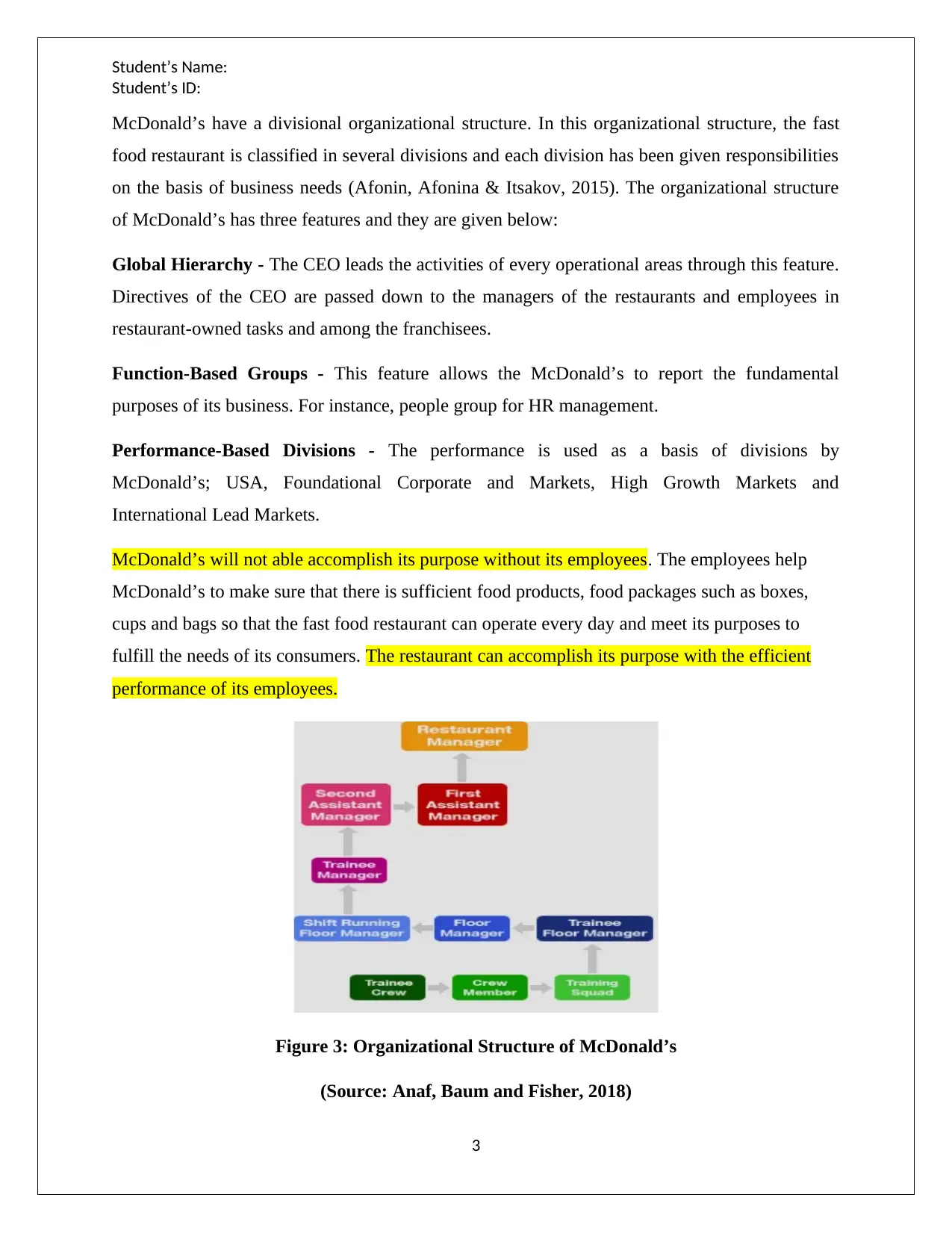
Student’s Name:
Student’s ID:
McDonald’s have a divisional organizational structure. In this organizational structure, the fast
food restaurant is classified in several divisions and each division has been given responsibilities
on the basis of business needs (Afonin, Afonina & Itsakov, 2015). The organizational structure
of McDonald’s has three features and they are given below:
Global Hierarchy - The CEO leads the activities of every operational areas through this feature.
Directives of the CEO are passed down to the managers of the restaurants and employees in
restaurant-owned tasks and among the franchisees.
Function-Based Groups - This feature allows the McDonald’s to report the fundamental
purposes of its business. For instance, people group for HR management.
Performance-Based Divisions - The performance is used as a basis of divisions by
McDonald’s; USA, Foundational Corporate and Markets, High Growth Markets and
International Lead Markets.
McDonald’s will not able accomplish its purpose without its employees. The employees help
McDonald’s to make sure that there is sufficient food products, food packages such as boxes,
cups and bags so that the fast food restaurant can operate every day and meet its purposes to
fulfill the needs of its consumers. The restaurant can accomplish its purpose with the efficient
performance of its employees.
Figure 3: Organizational Structure of McDonald’s
(Source: Anaf, Baum and Fisher, 2018)
3
Student’s ID:
McDonald’s have a divisional organizational structure. In this organizational structure, the fast
food restaurant is classified in several divisions and each division has been given responsibilities
on the basis of business needs (Afonin, Afonina & Itsakov, 2015). The organizational structure
of McDonald’s has three features and they are given below:
Global Hierarchy - The CEO leads the activities of every operational areas through this feature.
Directives of the CEO are passed down to the managers of the restaurants and employees in
restaurant-owned tasks and among the franchisees.
Function-Based Groups - This feature allows the McDonald’s to report the fundamental
purposes of its business. For instance, people group for HR management.
Performance-Based Divisions - The performance is used as a basis of divisions by
McDonald’s; USA, Foundational Corporate and Markets, High Growth Markets and
International Lead Markets.
McDonald’s will not able accomplish its purpose without its employees. The employees help
McDonald’s to make sure that there is sufficient food products, food packages such as boxes,
cups and bags so that the fast food restaurant can operate every day and meet its purposes to
fulfill the needs of its consumers. The restaurant can accomplish its purpose with the efficient
performance of its employees.
Figure 3: Organizational Structure of McDonald’s
(Source: Anaf, Baum and Fisher, 2018)
3
Paraphrase This Document
Need a fresh take? Get an instant paraphrase of this document with our AI Paraphraser
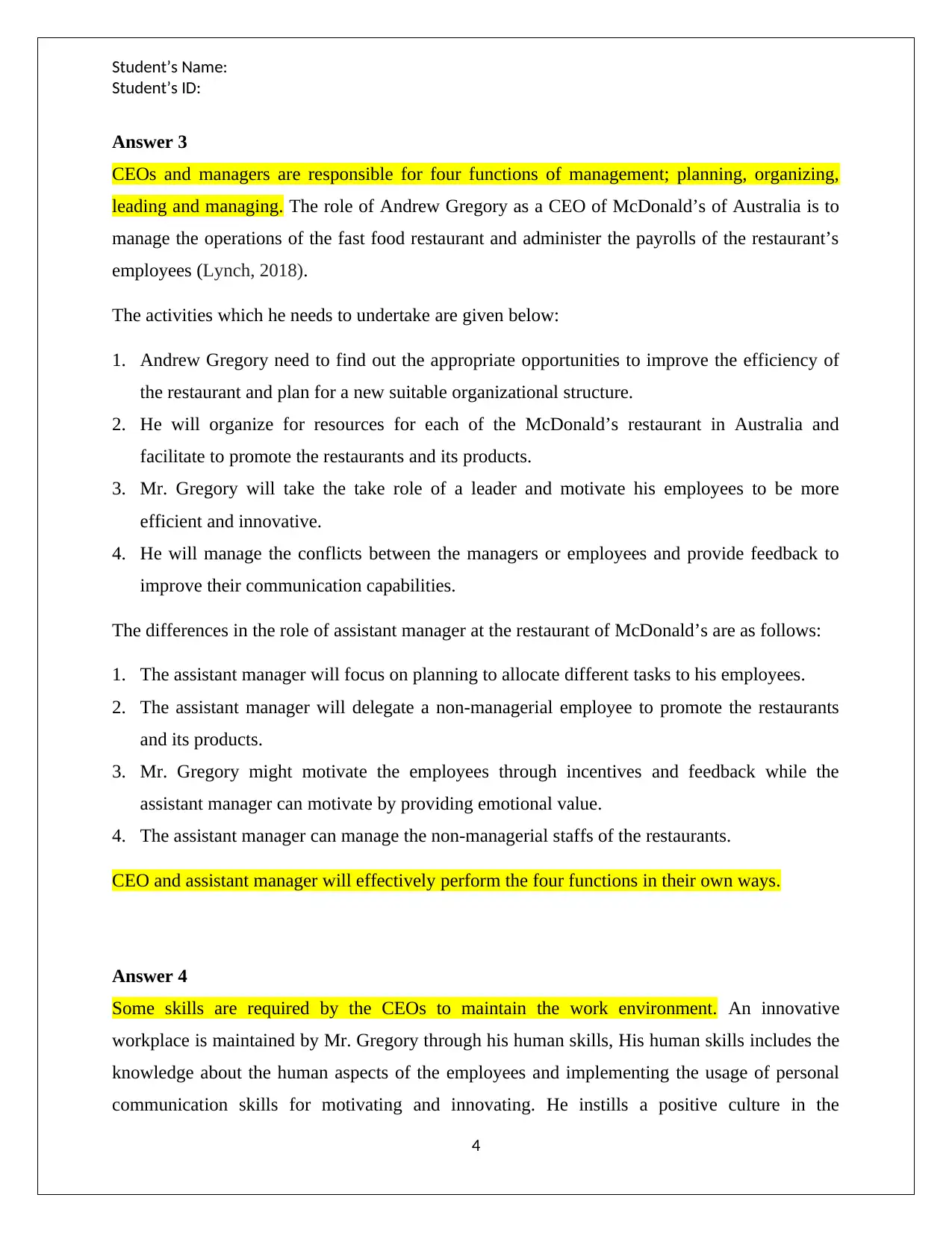
Student’s Name:
Student’s ID:
Answer 3
CEOs and managers are responsible for four functions of management; planning, organizing,
leading and managing. The role of Andrew Gregory as a CEO of McDonald’s of Australia is to
manage the operations of the fast food restaurant and administer the payrolls of the restaurant’s
employees (Lynch, 2018).
The activities which he needs to undertake are given below:
1. Andrew Gregory need to find out the appropriate opportunities to improve the efficiency of
the restaurant and plan for a new suitable organizational structure.
2. He will organize for resources for each of the McDonald’s restaurant in Australia and
facilitate to promote the restaurants and its products.
3. Mr. Gregory will take the take role of a leader and motivate his employees to be more
efficient and innovative.
4. He will manage the conflicts between the managers or employees and provide feedback to
improve their communication capabilities.
The differences in the role of assistant manager at the restaurant of McDonald’s are as follows:
1. The assistant manager will focus on planning to allocate different tasks to his employees.
2. The assistant manager will delegate a non-managerial employee to promote the restaurants
and its products.
3. Mr. Gregory might motivate the employees through incentives and feedback while the
assistant manager can motivate by providing emotional value.
4. The assistant manager can manage the non-managerial staffs of the restaurants.
CEO and assistant manager will effectively perform the four functions in their own ways.
Answer 4
Some skills are required by the CEOs to maintain the work environment. An innovative
workplace is maintained by Mr. Gregory through his human skills, His human skills includes the
knowledge about the human aspects of the employees and implementing the usage of personal
communication skills for motivating and innovating. He instills a positive culture in the
4
Student’s ID:
Answer 3
CEOs and managers are responsible for four functions of management; planning, organizing,
leading and managing. The role of Andrew Gregory as a CEO of McDonald’s of Australia is to
manage the operations of the fast food restaurant and administer the payrolls of the restaurant’s
employees (Lynch, 2018).
The activities which he needs to undertake are given below:
1. Andrew Gregory need to find out the appropriate opportunities to improve the efficiency of
the restaurant and plan for a new suitable organizational structure.
2. He will organize for resources for each of the McDonald’s restaurant in Australia and
facilitate to promote the restaurants and its products.
3. Mr. Gregory will take the take role of a leader and motivate his employees to be more
efficient and innovative.
4. He will manage the conflicts between the managers or employees and provide feedback to
improve their communication capabilities.
The differences in the role of assistant manager at the restaurant of McDonald’s are as follows:
1. The assistant manager will focus on planning to allocate different tasks to his employees.
2. The assistant manager will delegate a non-managerial employee to promote the restaurants
and its products.
3. Mr. Gregory might motivate the employees through incentives and feedback while the
assistant manager can motivate by providing emotional value.
4. The assistant manager can manage the non-managerial staffs of the restaurants.
CEO and assistant manager will effectively perform the four functions in their own ways.
Answer 4
Some skills are required by the CEOs to maintain the work environment. An innovative
workplace is maintained by Mr. Gregory through his human skills, His human skills includes the
knowledge about the human aspects of the employees and implementing the usage of personal
communication skills for motivating and innovating. He instills a positive culture in the
4
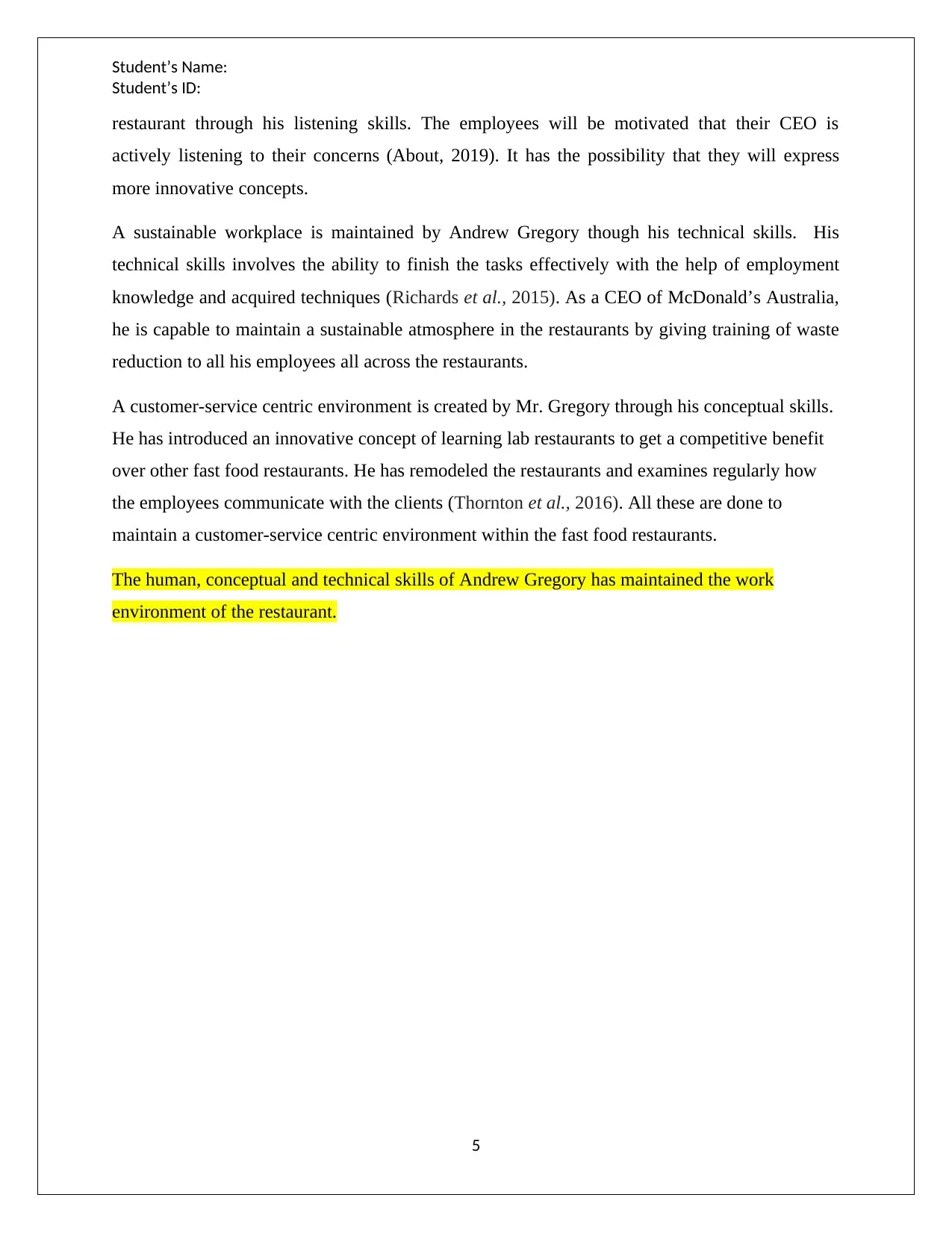
Student’s Name:
Student’s ID:
restaurant through his listening skills. The employees will be motivated that their CEO is
actively listening to their concerns (About, 2019). It has the possibility that they will express
more innovative concepts.
A sustainable workplace is maintained by Andrew Gregory though his technical skills. His
technical skills involves the ability to finish the tasks effectively with the help of employment
knowledge and acquired techniques (Richards et al., 2015). As a CEO of McDonald’s Australia,
he is capable to maintain a sustainable atmosphere in the restaurants by giving training of waste
reduction to all his employees all across the restaurants.
A customer-service centric environment is created by Mr. Gregory through his conceptual skills.
He has introduced an innovative concept of learning lab restaurants to get a competitive benefit
over other fast food restaurants. He has remodeled the restaurants and examines regularly how
the employees communicate with the clients (Thornton et al., 2016). All these are done to
maintain a customer-service centric environment within the fast food restaurants.
The human, conceptual and technical skills of Andrew Gregory has maintained the work
environment of the restaurant.
5
Student’s ID:
restaurant through his listening skills. The employees will be motivated that their CEO is
actively listening to their concerns (About, 2019). It has the possibility that they will express
more innovative concepts.
A sustainable workplace is maintained by Andrew Gregory though his technical skills. His
technical skills involves the ability to finish the tasks effectively with the help of employment
knowledge and acquired techniques (Richards et al., 2015). As a CEO of McDonald’s Australia,
he is capable to maintain a sustainable atmosphere in the restaurants by giving training of waste
reduction to all his employees all across the restaurants.
A customer-service centric environment is created by Mr. Gregory through his conceptual skills.
He has introduced an innovative concept of learning lab restaurants to get a competitive benefit
over other fast food restaurants. He has remodeled the restaurants and examines regularly how
the employees communicate with the clients (Thornton et al., 2016). All these are done to
maintain a customer-service centric environment within the fast food restaurants.
The human, conceptual and technical skills of Andrew Gregory has maintained the work
environment of the restaurant.
5
⊘ This is a preview!⊘
Do you want full access?
Subscribe today to unlock all pages.

Trusted by 1+ million students worldwide
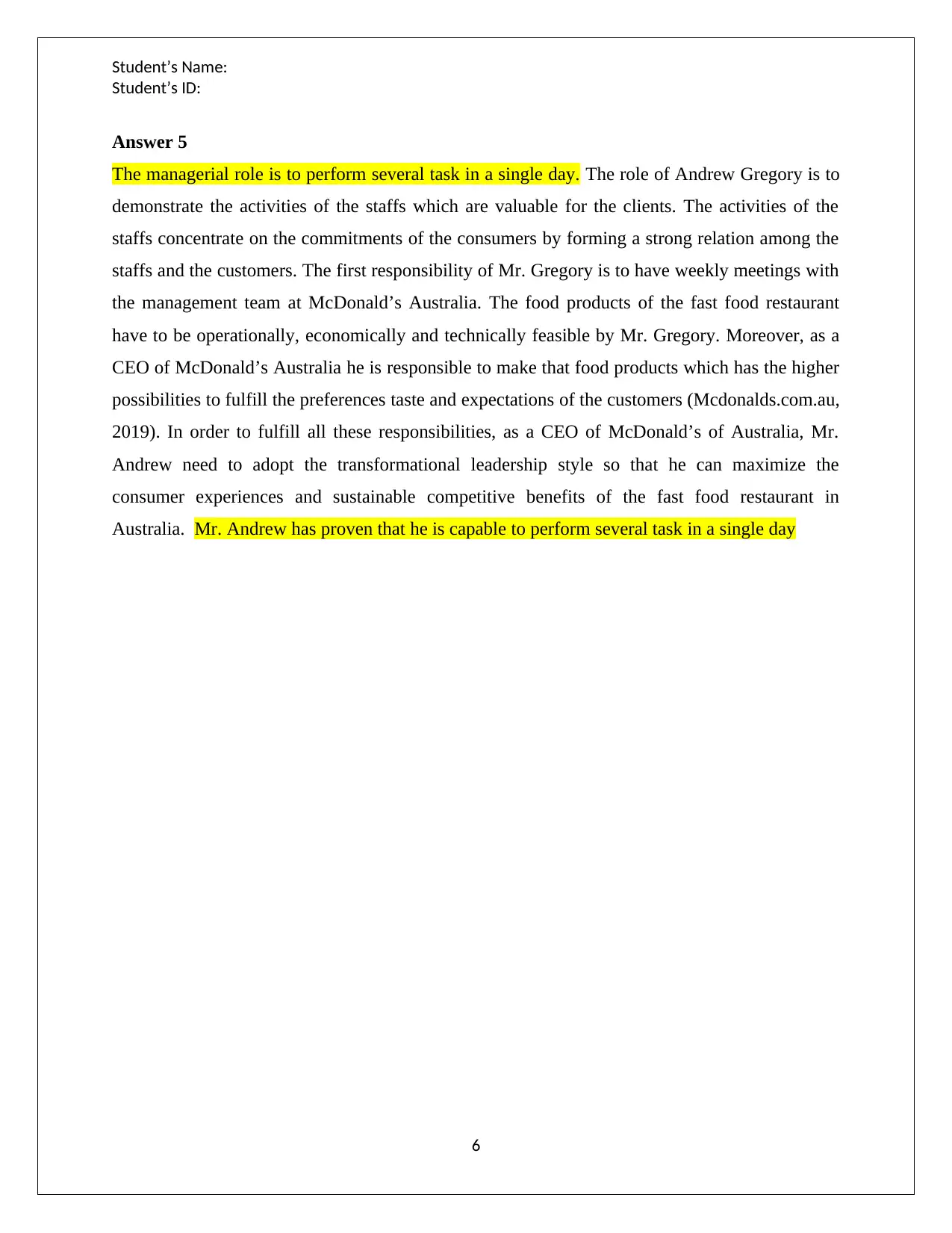
Student’s Name:
Student’s ID:
Answer 5
The managerial role is to perform several task in a single day. The role of Andrew Gregory is to
demonstrate the activities of the staffs which are valuable for the clients. The activities of the
staffs concentrate on the commitments of the consumers by forming a strong relation among the
staffs and the customers. The first responsibility of Mr. Gregory is to have weekly meetings with
the management team at McDonald’s Australia. The food products of the fast food restaurant
have to be operationally, economically and technically feasible by Mr. Gregory. Moreover, as a
CEO of McDonald’s Australia he is responsible to make that food products which has the higher
possibilities to fulfill the preferences taste and expectations of the customers (Mcdonalds.com.au,
2019). In order to fulfill all these responsibilities, as a CEO of McDonald’s of Australia, Mr.
Andrew need to adopt the transformational leadership style so that he can maximize the
consumer experiences and sustainable competitive benefits of the fast food restaurant in
Australia. Mr. Andrew has proven that he is capable to perform several task in a single day
6
Student’s ID:
Answer 5
The managerial role is to perform several task in a single day. The role of Andrew Gregory is to
demonstrate the activities of the staffs which are valuable for the clients. The activities of the
staffs concentrate on the commitments of the consumers by forming a strong relation among the
staffs and the customers. The first responsibility of Mr. Gregory is to have weekly meetings with
the management team at McDonald’s Australia. The food products of the fast food restaurant
have to be operationally, economically and technically feasible by Mr. Gregory. Moreover, as a
CEO of McDonald’s Australia he is responsible to make that food products which has the higher
possibilities to fulfill the preferences taste and expectations of the customers (Mcdonalds.com.au,
2019). In order to fulfill all these responsibilities, as a CEO of McDonald’s of Australia, Mr.
Andrew need to adopt the transformational leadership style so that he can maximize the
consumer experiences and sustainable competitive benefits of the fast food restaurant in
Australia. Mr. Andrew has proven that he is capable to perform several task in a single day
6
Paraphrase This Document
Need a fresh take? Get an instant paraphrase of this document with our AI Paraphraser
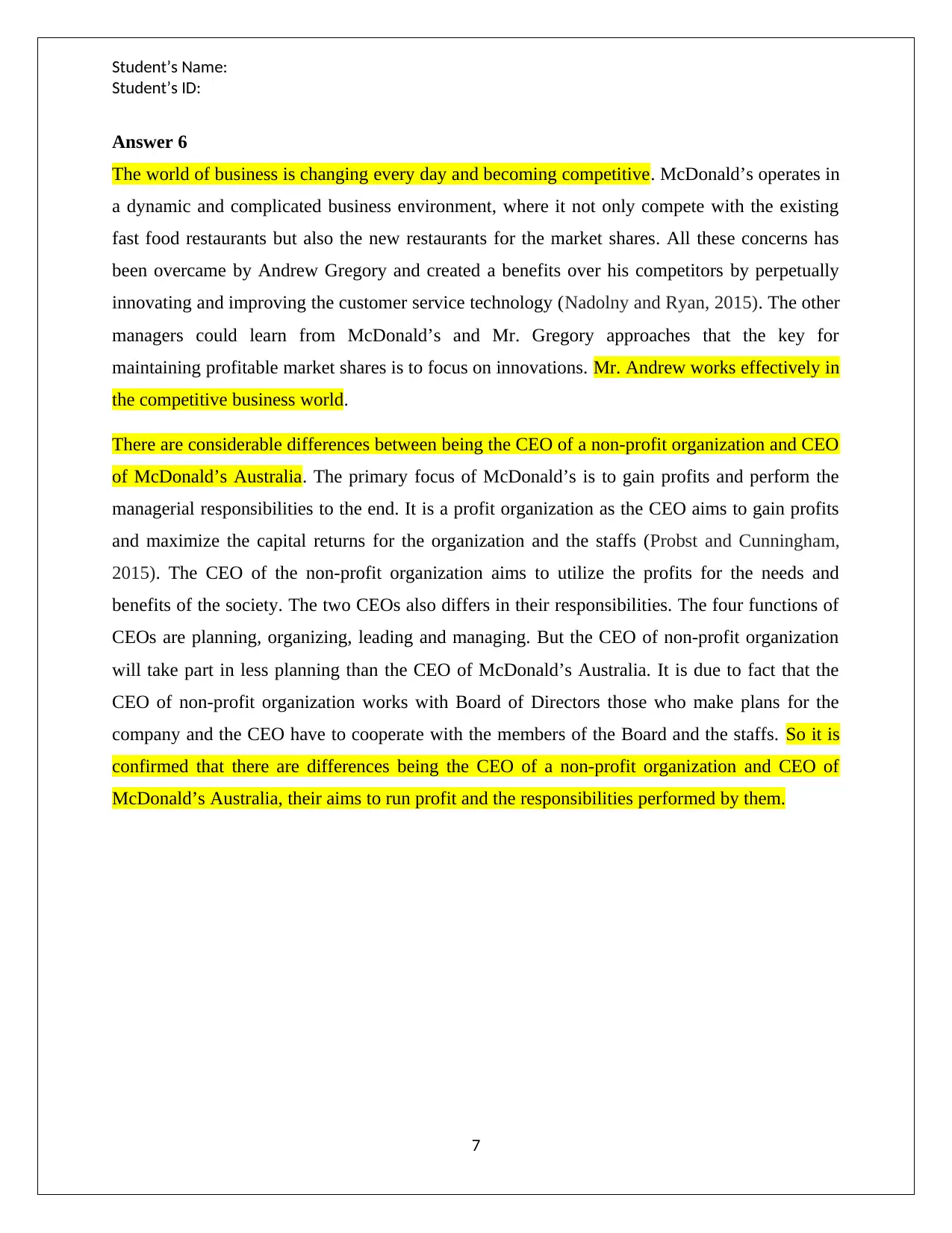
Student’s Name:
Student’s ID:
Answer 6
The world of business is changing every day and becoming competitive. McDonald’s operates in
a dynamic and complicated business environment, where it not only compete with the existing
fast food restaurants but also the new restaurants for the market shares. All these concerns has
been overcame by Andrew Gregory and created a benefits over his competitors by perpetually
innovating and improving the customer service technology (Nadolny and Ryan, 2015). The other
managers could learn from McDonald’s and Mr. Gregory approaches that the key for
maintaining profitable market shares is to focus on innovations. Mr. Andrew works effectively in
the competitive business world.
There are considerable differences between being the CEO of a non-profit organization and CEO
of McDonald’s Australia. The primary focus of McDonald’s is to gain profits and perform the
managerial responsibilities to the end. It is a profit organization as the CEO aims to gain profits
and maximize the capital returns for the organization and the staffs (Probst and Cunningham,
2015). The CEO of the non-profit organization aims to utilize the profits for the needs and
benefits of the society. The two CEOs also differs in their responsibilities. The four functions of
CEOs are planning, organizing, leading and managing. But the CEO of non-profit organization
will take part in less planning than the CEO of McDonald’s Australia. It is due to fact that the
CEO of non-profit organization works with Board of Directors those who make plans for the
company and the CEO have to cooperate with the members of the Board and the staffs. So it is
confirmed that there are differences being the CEO of a non-profit organization and CEO of
McDonald’s Australia, their aims to run profit and the responsibilities performed by them.
7
Student’s ID:
Answer 6
The world of business is changing every day and becoming competitive. McDonald’s operates in
a dynamic and complicated business environment, where it not only compete with the existing
fast food restaurants but also the new restaurants for the market shares. All these concerns has
been overcame by Andrew Gregory and created a benefits over his competitors by perpetually
innovating and improving the customer service technology (Nadolny and Ryan, 2015). The other
managers could learn from McDonald’s and Mr. Gregory approaches that the key for
maintaining profitable market shares is to focus on innovations. Mr. Andrew works effectively in
the competitive business world.
There are considerable differences between being the CEO of a non-profit organization and CEO
of McDonald’s Australia. The primary focus of McDonald’s is to gain profits and perform the
managerial responsibilities to the end. It is a profit organization as the CEO aims to gain profits
and maximize the capital returns for the organization and the staffs (Probst and Cunningham,
2015). The CEO of the non-profit organization aims to utilize the profits for the needs and
benefits of the society. The two CEOs also differs in their responsibilities. The four functions of
CEOs are planning, organizing, leading and managing. But the CEO of non-profit organization
will take part in less planning than the CEO of McDonald’s Australia. It is due to fact that the
CEO of non-profit organization works with Board of Directors those who make plans for the
company and the CEO have to cooperate with the members of the Board and the staffs. So it is
confirmed that there are differences being the CEO of a non-profit organization and CEO of
McDonald’s Australia, their aims to run profit and the responsibilities performed by them.
7
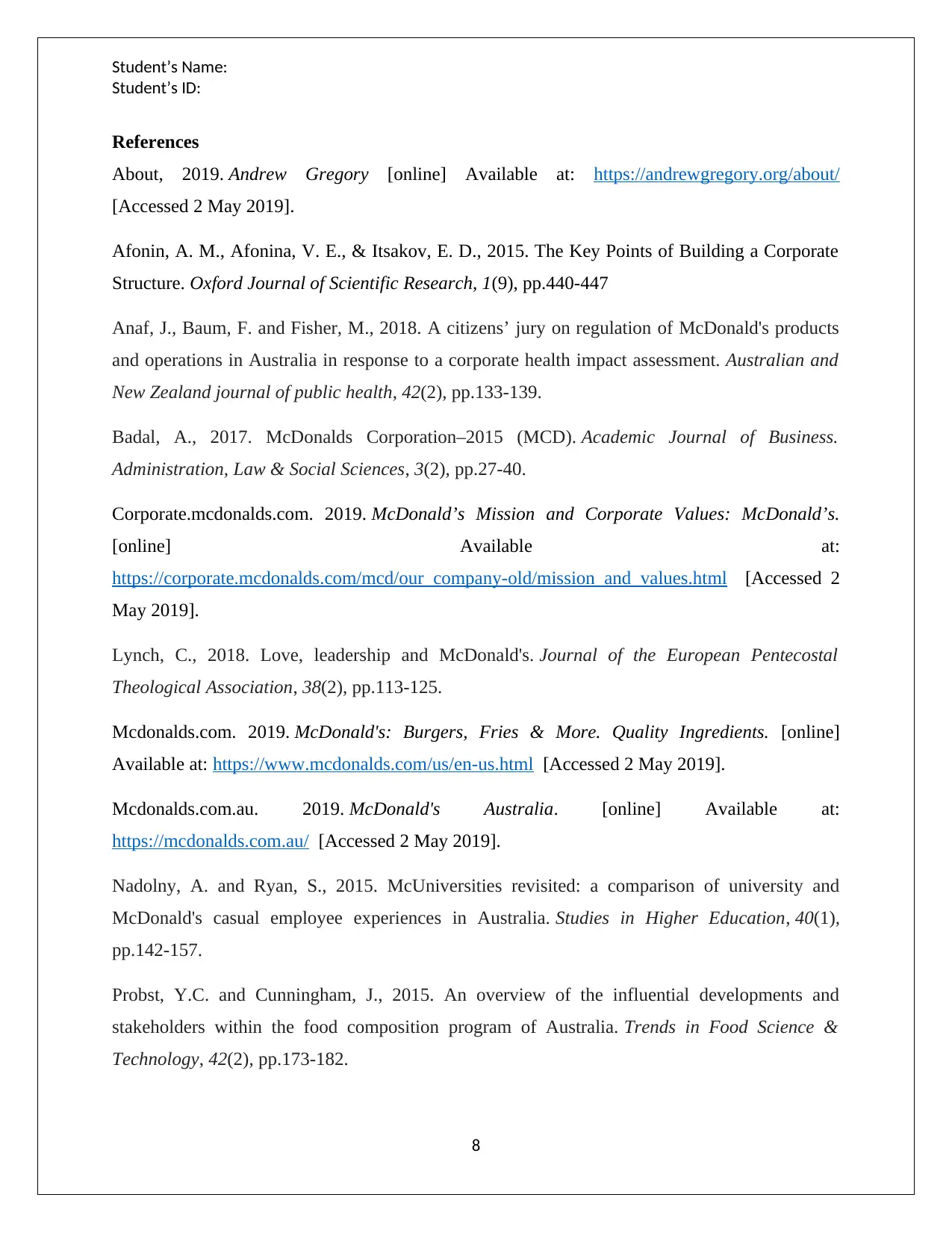
Student’s Name:
Student’s ID:
References
About, 2019. Andrew Gregory [online] Available at: https://andrewgregory.org/about/
[Accessed 2 May 2019].
Afonin, A. M., Afonina, V. E., & Itsakov, E. D., 2015. The Key Points of Building a Corporate
Structure. Oxford Journal of Scientific Research, 1(9), pp.440-447
Anaf, J., Baum, F. and Fisher, M., 2018. A citizens’ jury on regulation of McDonald's products
and operations in Australia in response to a corporate health impact assessment. Australian and
New Zealand journal of public health, 42(2), pp.133-139.
Badal, A., 2017. McDonalds Corporation–2015 (MCD). Academic Journal of Business.
Administration, Law & Social Sciences, 3(2), pp.27-40.
Corporate.mcdonalds.com. 2019. McDonald’s Mission and Corporate Values: McDonald’s.
[online] Available at:
https://corporate.mcdonalds.com/mcd/our_company-old/mission_and_values.html [Accessed 2
May 2019].
Lynch, C., 2018. Love, leadership and McDonald's. Journal of the European Pentecostal
Theological Association, 38(2), pp.113-125.
Mcdonalds.com. 2019. McDonald's: Burgers, Fries & More. Quality Ingredients. [online]
Available at: https://www.mcdonalds.com/us/en-us.html [Accessed 2 May 2019].
Mcdonalds.com.au. 2019. McDonald's Australia. [online] Available at:
https://mcdonalds.com.au/ [Accessed 2 May 2019].
Nadolny, A. and Ryan, S., 2015. McUniversities revisited: a comparison of university and
McDonald's casual employee experiences in Australia. Studies in Higher Education, 40(1),
pp.142-157.
Probst, Y.C. and Cunningham, J., 2015. An overview of the influential developments and
stakeholders within the food composition program of Australia. Trends in Food Science &
Technology, 42(2), pp.173-182.
8
Student’s ID:
References
About, 2019. Andrew Gregory [online] Available at: https://andrewgregory.org/about/
[Accessed 2 May 2019].
Afonin, A. M., Afonina, V. E., & Itsakov, E. D., 2015. The Key Points of Building a Corporate
Structure. Oxford Journal of Scientific Research, 1(9), pp.440-447
Anaf, J., Baum, F. and Fisher, M., 2018. A citizens’ jury on regulation of McDonald's products
and operations in Australia in response to a corporate health impact assessment. Australian and
New Zealand journal of public health, 42(2), pp.133-139.
Badal, A., 2017. McDonalds Corporation–2015 (MCD). Academic Journal of Business.
Administration, Law & Social Sciences, 3(2), pp.27-40.
Corporate.mcdonalds.com. 2019. McDonald’s Mission and Corporate Values: McDonald’s.
[online] Available at:
https://corporate.mcdonalds.com/mcd/our_company-old/mission_and_values.html [Accessed 2
May 2019].
Lynch, C., 2018. Love, leadership and McDonald's. Journal of the European Pentecostal
Theological Association, 38(2), pp.113-125.
Mcdonalds.com. 2019. McDonald's: Burgers, Fries & More. Quality Ingredients. [online]
Available at: https://www.mcdonalds.com/us/en-us.html [Accessed 2 May 2019].
Mcdonalds.com.au. 2019. McDonald's Australia. [online] Available at:
https://mcdonalds.com.au/ [Accessed 2 May 2019].
Nadolny, A. and Ryan, S., 2015. McUniversities revisited: a comparison of university and
McDonald's casual employee experiences in Australia. Studies in Higher Education, 40(1),
pp.142-157.
Probst, Y.C. and Cunningham, J., 2015. An overview of the influential developments and
stakeholders within the food composition program of Australia. Trends in Food Science &
Technology, 42(2), pp.173-182.
8
⊘ This is a preview!⊘
Do you want full access?
Subscribe today to unlock all pages.

Trusted by 1+ million students worldwide

Student’s Name:
Student’s ID:
Richards, Z., Thomas, S.L., Randle, M. and Pettigrew, S., 2015. Corporate Social Responsibility
programs of Big Food in Australia: a content analysis of industry documents. Australian and
New Zealand journal of public health, 39(6), pp.550-556.
Thornton, L.E., Ball, K., Lamb, K.E., McCann, J., Parker, K. and Crawford, D.A., 2016. The
impact of a new McDonald's restaurant on eating behaviours and perceptions of local residents:
A natural experiment using repeated cross-sectional data. Health & place, 39, pp.86-91.
9
Student’s ID:
Richards, Z., Thomas, S.L., Randle, M. and Pettigrew, S., 2015. Corporate Social Responsibility
programs of Big Food in Australia: a content analysis of industry documents. Australian and
New Zealand journal of public health, 39(6), pp.550-556.
Thornton, L.E., Ball, K., Lamb, K.E., McCann, J., Parker, K. and Crawford, D.A., 2016. The
impact of a new McDonald's restaurant on eating behaviours and perceptions of local residents:
A natural experiment using repeated cross-sectional data. Health & place, 39, pp.86-91.
9
1 out of 10
Related Documents
Your All-in-One AI-Powered Toolkit for Academic Success.
+13062052269
info@desklib.com
Available 24*7 on WhatsApp / Email
![[object Object]](/_next/static/media/star-bottom.7253800d.svg)
Unlock your academic potential
Copyright © 2020–2025 A2Z Services. All Rights Reserved. Developed and managed by ZUCOL.





